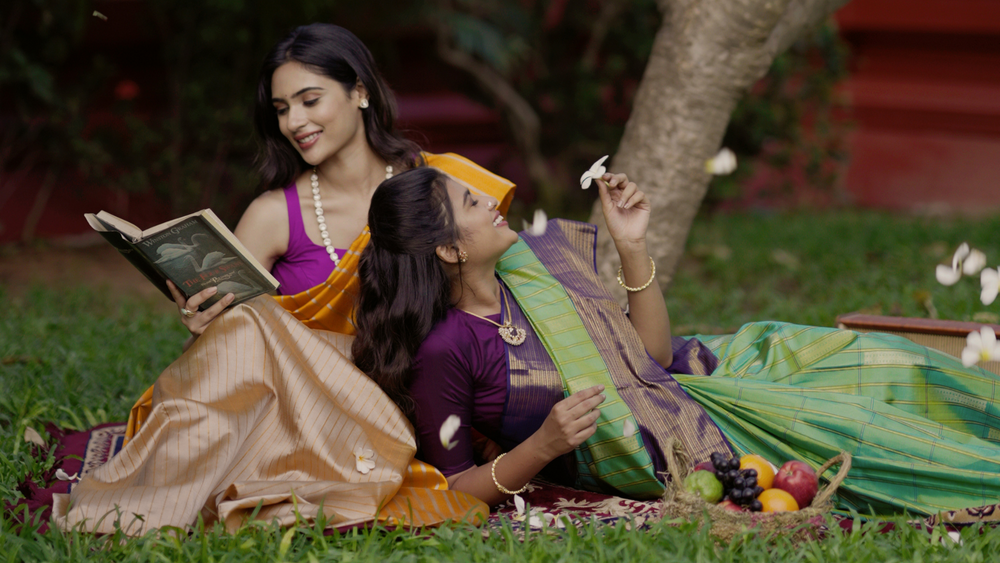How to Maintain a Kanjivaram Silk Saree
Kanjivaram sarees, made of several layers of finely woven silk cloth, have long dominated wedding ceremonies and other significant occasions in southern India. Their popularity has only grown over time, and has cemented their status as one of the finest silken weaves to be found. From ancient queens to powerful women today, these gilded masterpieces have attracted anyone wanting to make a sophisticated and opulent statement. These sarees are incredibly in demand all around the world thanks to the tough nature and long life of the Kanchipuram silk weave. It is no wonder that every saree-loving woman would wish to have this stunning silk saree in her closet, whether it be for weddings or just to make a statement.

Kanjivaram silks are known for their grand look, but this look is achieved due to the intricately spun silk and durable yet delicate nature of the material. To ensure your precious Kanjivaram silk sarees remain in top condition for many years, it helps to be careful about the way you maintain and clean your woven work of art. While Kanjivaram silk is known for lasting decades without losing its sheen, some extra care while storing and donning these sarees can go a long way in making sure your favourite weave becomes a beloved family heirloom for generations to come. These sarees may be sensitive to the elements, but the older and more loved a saree becomes, the more valuable it is. Simply put, the Kanjivaram silk saree ages like fine wine!
Here are some tips on how to maintain this classic weave:
Storing your Kanjivaram Saree:
- Once you bring any new saree home, remove the packaging and discard it. Make sure you do not store the saree in close proximity to plastic or newspaper print, as these will damage its delicate material.
- It is best to store it separately from sarees made of other materials. Store it in a cloth bag (preferable cotton or muslin) and not together with other sarees. Keep the saree in a cool space away from sunlight and artificial heating like heaters and the like.
- If you store the saree with other silk sarees, lay them flat and folded on shelves, not more than four to five sarees in one stack. If the sarees are bridal sarees or have heavy embroidery, it is better to keep fewer sarees together.
- Never use metal hangers to hang your Kanjivaram sarees. Hangers may leave permanent marks and ruin the smooth and pristine look of the saree.
- Pay a visit to the tailor to cleanly remove the attached blouse material. Then get the edges knotted into tassels to avoid the individual threads separating and causing the saree to unravel.
- The saree may feel a little stiff if the weavers have used starch in the weaving process. While the saree will feel softer as it gets used, you can shake off some of the starched effect by unwrapping, gently shaking it, and then folding it again.
- How you fold the Kanjivaram saree is very important. Make sure you fold it such that the zari borders are protected and not damaged. Folding the zari so that it is on the inside is a great tip, because it will protect the zari from the elements and make its sheen last longer.
- Every three to four months or so, ensure you air out the Kanjivaram saree. Unfold it and spread it out, either in the shade or simply indoors in your room. Let it air out for a couple of hours, and then refold it so that the previous folds are not repeated. This ensures the vibrant colours of the saree do not fade, and the folds do not create permanent creases in the material. This airing process also gets rid of any musty smells coming from the saree. The airing process is vital if you want your Kanjivaram saree to last for a long time while maintaining its colours, sheen, and quality.
- To prevent pests like moths or fungus, use silica gel in the storage area. For a natural alternative, place some neem leaves near the saree. They work as natural pest control. Do not keep the neem leaves directly next to the saree; either dry them out or wrap them in a paper or cloth before placing them near your Kanjivaram sarees.
- Avoid using naphthalene balls, air freshener sprays and other chemicals as these could cause the colours to leach or damage the saree. These could also cause discoloration of the delicate zari work on the saree.

Wearing the Saree:
-
When you drape your beautiful Kanjivaram silk saree, avoid using any chemical-based sprays on top of it, including deodorants and perfumes. These will cause discolouration and damage to the intricate zari work and the silk itself.
-
After every outing, the Kanjivaram saree needs to be aired out for a few hours.
Washing/Cleaning Your Kanjivaram Saree:
- It is highly recommended that you avoid washing the saree like you would with any other fabric. The silk is delicate and washing it in the usual way, even by hand, can cause irreparable damage to the colours and the fine zari and embroidery work.
- After every use, it is good to get the saree professionally dry cleaned. This should remove any light stains or dirt without causing water damage.
- A gentle ironing will also help restore the folds, so you can store it safely and neatly without any damage.
- If you would prefer to hand wash the saree at home to remove tough stains, make sure you only use cold water for the first couple of washes.
- After the cold washes, use a light shampoo to get rid of stains. Do not use detergents as these harsh chemicals will do great damage to the material and colours of the saree.
- It is better to do a small test with a patch of the saree to see how it is affected by the water or shampoo, and then proceed if it does not react badly
- Hand washing each section of the saree is essential, and go slowly and gently to avoid any unnecessary damage to the saree.
- For another natural, time-tested cleaning solution, turn to soapberries or Poovanthi as they are called in Tamil. These berries are traditionally used as a natural shampoo, but they also work as an organic, chemical-free, skin-safe cleaning agent for your precious Kanjivaram silks.
- After cleaning, never wring out the water from your Kanjivaram saree. Wringing will definitely wrinkle, crease, and damage the delicate fabric and zari work on it. Dry the saree by removing excess water with a dry towel, and then dry it in shade for a few hours.
- If you feel your saree has lost its sheen after years of use, there is a method you can use to restore it. Mix a quarter cup of white vinegar in a bucket of water and wash the saree with it. Rinse the saree in cold water afterwards to remove all the vinegar.

To Remove Stains
- If the stain is water soluble, i.e., can easily be removed using just water, then take a piece of cotton, soak it in plain water, and then gently dab it over the stained area. Do this until the stain comes off. Dry the saree in a shady area and then iron to prevent creasing.
- For tougher stains, cleaning gets a little trickier to do. You should still avoid washing the entire saree, and rather focus on cleaning out the stain from the particular spot it is in.
- Use some cotton dipped in a solvent (acetone or a similar) to remove stains off dark-colored saris.
- For sarees in lighter shades, the process is different. First, apply some talcum powder to the discoloured region of light-colored saris and wait for the pigment to absorb. Clear away any extra talcum powder. If the stain refuses to go,test a tiny area with acetone to see if the stain spreads. If it does not, proceed with the process previously mentioned for dark colours.
Ironing your Kanjivaram Saree
- Ironing your Kanjivaram saree should be a careful endeavour, and you must take special care. Either give it to a specialist or follow the tips below to ensure your saree remains undamaged.
- Never apply the iron to the saree directly. Always make sure you have a cloth covering the saree, preferably a cotton one. This will reduce the risk of burning the saree while ironing.
- Use very little pressure when ironing. The material is delicate and applying too much pressure will ruin the saree easily.
- Keep the heat on your iron at the prescribed temperature given for silks. Do not iron while in other settings to avoid burning or damaging the saree.
- Use a steam iron for Kanjivaram silks, as it removes creases efficiently and makes the saree smooth and neat.
- When ironing, move only in one direction and not back and forth, to prevent folding and creasing.
Follow these tips to keep your prized Kanjivaram silks in prime condition, ready to be worn when the occasion comes. While maintaining these fine weaves may seem daunting at first, with some care and effort, your sarees will remain in fine condition for years and even decades. Their quality and craftsmanship is such that with care, they will become increasingly invaluable handlooms, to be worn and adored by every passing generation.



Leave a comment